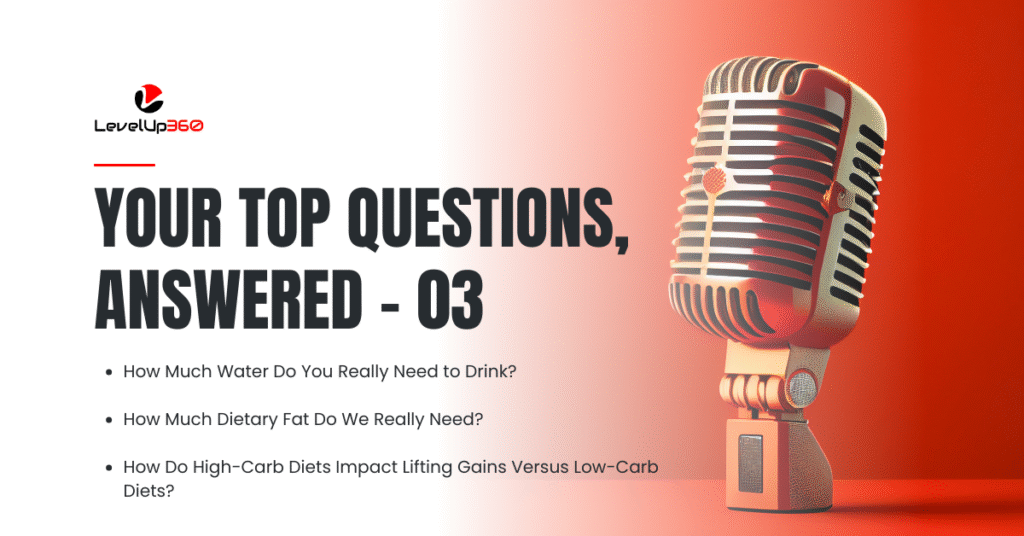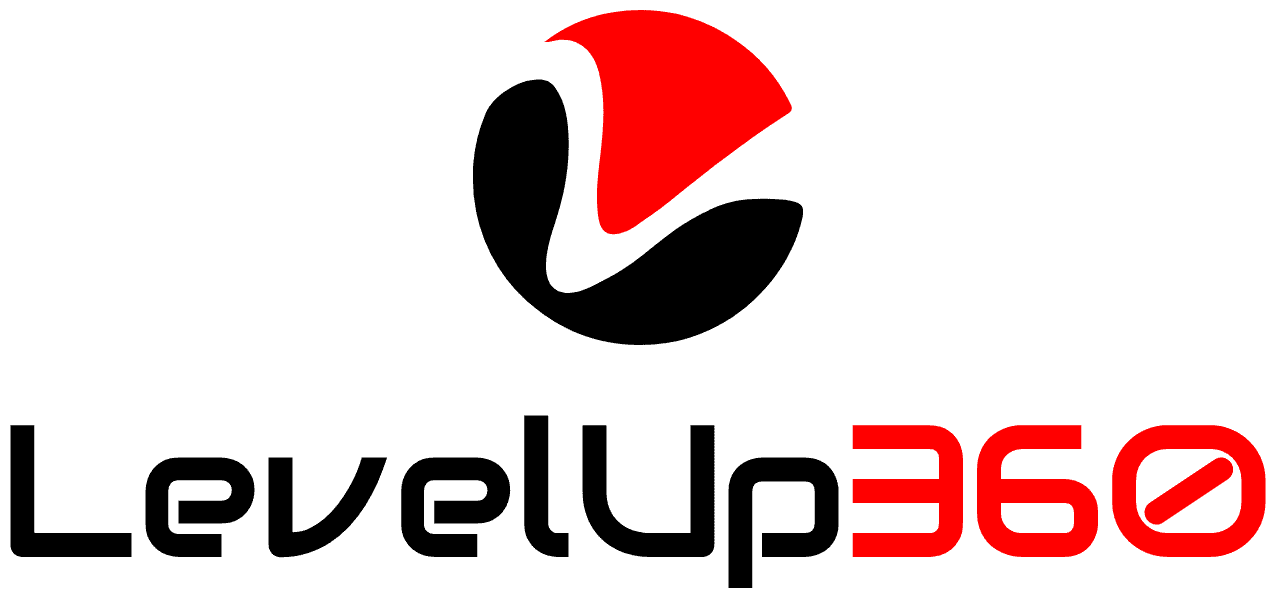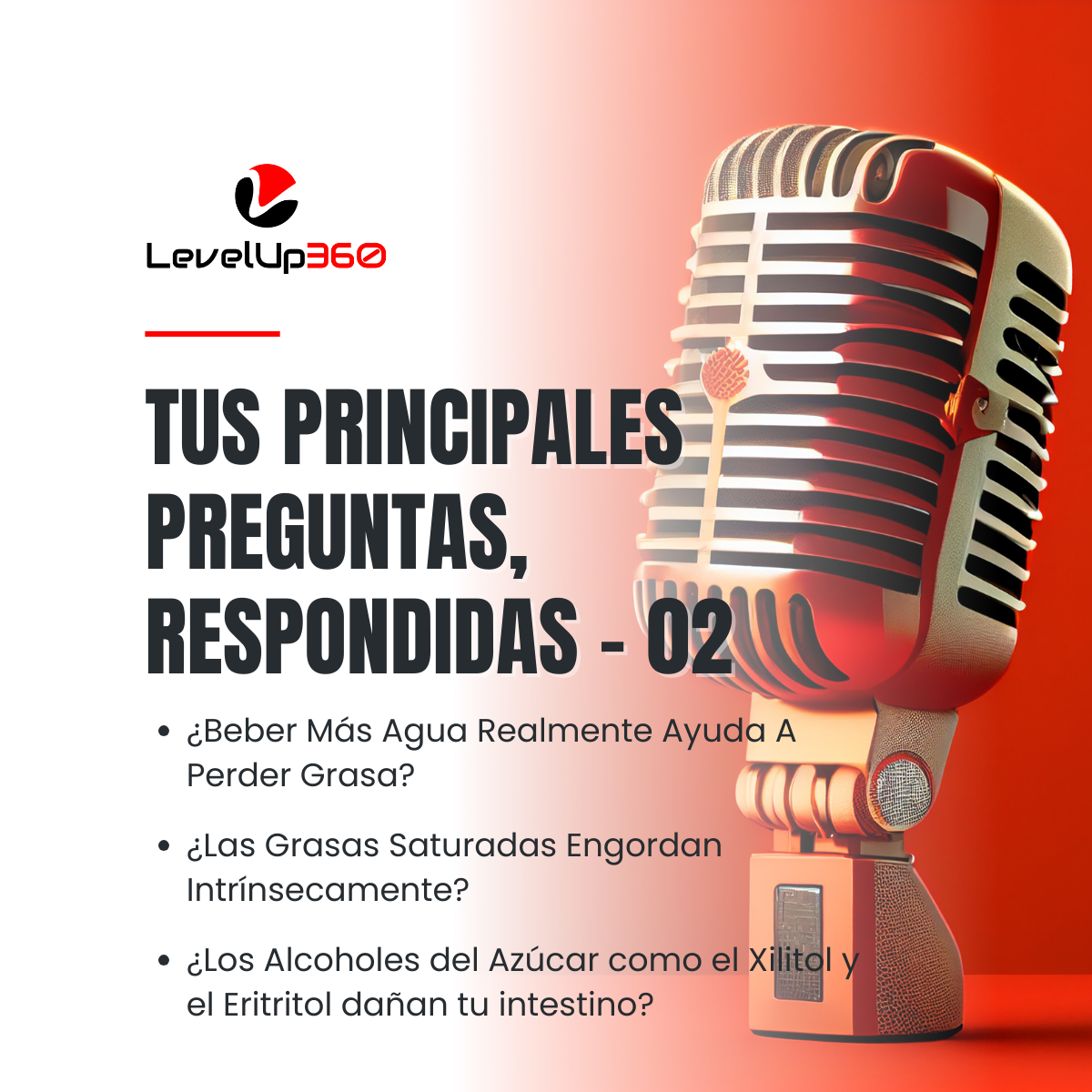
Respuestas a tus Principales Preguntas sobre Salud y Forma Física:
- How Much Water Do You Really Need to Drink?
- How Much Dietary Fat Do We Really Need?
- How Do High-Carb Diets Impact Lifting Gains Versus Low-Carb Diets?
En este artículo de preguntas y respuestas abordamos algunos temas de nutrición muy debatidos, analizando las últimas investigaciones científicas y traduciéndolas en consejos sencillos y prácticos que puedes poner en práctica en tu vida. Sigue leyendo para obtener respuestas respaldadas por la ciencia sobre los efectos del agua en la pérdida de grasa, la verdad sobre las grasas saturadas y la composición corporal, y los efectos de los edulcorantes del alcohol y el azúcar en la digestión. Traducción realizada con la versión gratuita del traductor DeepL.com
How Much Water Do You Really Need to Drink?
Pregunta
How much water should I aim to drink each day for optimal hydration?
Respuesta
Determining your optimal daily water intake is quite complex, with many factors influencing your individual needs. There is no universal recommendation that applies equally to all people. However, we can examine common rules of thumb, estimate water turnover, and use simple hydration markers to help gauge your personal requirements.
A longstanding general guideline has been to drink 8 glasses of water per day, which equals around 1.9 litres. This originated decades ago as a very rough estimate for sedentary people in temperate climates. It was not based on rigorous scientific evidence.
For most inactive adults, 8 glasses remains a reasonable starting point. But active individuals, athletes, those in hot or humid environments, and people with larger bodies may need substantially more than this generic rule.
On the other end of the spectrum, smaller sedentary people in cool climates may be perfectly hydrated with intakes closer to 6-7 glasses daily. So this blanket 8-glass recommendation fails to account for individual differences.
A more personalized approach involves estimating your body’s daily water turnover rate. This is the amount of water your body loses and needs to replace each day to maintain hydration. Several complex equations exist to predict turnover based on your age, sex, body size, climate, activity level, and other factors.
However, a simpler method is monitoring your urine colour and morning body weight. Pale yellow to clear urine generally signals you are well hydrated. Dark yellow concentrated urine indicates inadequate water intake. Your body weight should also remain fairly stable day-to-day when properly hydrated.
Aim to replace sweat losses during exercise and consume enough total fluids from water, other beverages, and food to maintain light coloured urine and a stable morning body weight. If urine gets too dark or body weight drops, increase your intake. If your urine becomes completely clear with excessive drinking, you can likely reduce fluid intake.
This personalized adjustment of water consumption to match outputs will ensure you meet your specific hydration needs, which may differ significantly from general guidelines.
For most active adults, daily water intakes from all sources typically range from 2-4 litres. Athletes training in heat and humidity may need over 5 litres. Better indicators than a rigid intake target are properly dilute urine and stable body weight signalling your fluid intake appropriately matches your individual water turnover rate.
Conclusión
Rather than relying on generic water intake guidelines, monitor your urine colour, weight changes, and thirst as personalized cues to drink enough fluids to adequately replace water losses.
How Much Dietary Fat Do We Really Need?
Pregunta
What is the bare minimum daily fat intake needed to support health?
Respuesta
Despite fat being crucial for health, the exact minimum intake needed remains unclear but likely falls somewhere between 15-60+ grams per day depending on the specific health outcome we are looking to optimize.
If the sole objective is preventing gallstone formation during rapid weight loss, as little as 7-12 grams of fat per day may be sufficient. However, for long-term health more factors must be considered.
Obtaining adequate essential fatty acids is important for proper cell membrane function, inflammation modulation, brain development, and other critical roles. For omega-6 fats specifically, recommendations range from around 12-17 grams per day for adults. For omega-3s, targets are set at 1-2 grams daily.
Since even rich sources like oils and fatty fish provide a mix of different types of fats, your total intake needs to be higher than these guidelines to meet essential fat needs. Fitting in at least 20-30 grams daily allows leeway to obtain key omega-3s and omega-6s.
Consuming some fat is also necessary for the absorption and utilization of fat-soluble vitamins A, D, E, and K. Studies show fat intakes of around 20-30 grams per day help optimize vitamin absorption, further supporting this as a reasonable minimum.
In terms of optimizing health and function, there are cases where higher intakes may be warranted. For example, diets too low in fat can negatively impact hormone levels. Providing around 25-30% of calories from fat, or about 40-60+ grams daily, ensures adequate support for maintaining normal circulating hormones.
Considering all of these factors – avoiding gallstones, essential fatty acids, vitamin absorption, and hormones – most healthy adults likely need at least 20-30 grams of fat per day at a minimum, with active individuals and those eating higher calorie diets settling into the upper end of that range.
However, focusing on fat quality from whole food sources like fatty fish, nuts, seeds, avocados, and extra virgin olive oil rather than just hitting a quantitative target provides the best support for overall health.
Conclusión
While recommendations vary, a prudent minimum fat intake for most adults is around 20-30 grams daily from a balanced mix of healthy sources to meet essential needs.
How Do High-Carb Diets Impact Lifting Gains Versus Low-Carb Diets?
Pregunta
Will eating a high-carb or low-carb diet fuel better results from my strength training program?
Respuesta
This depends substantially on your specific training goals, program structure, and individual tolerance to varying carb intakes. But for most lifters doing moderate-high volume hypertrophy training, moderate-higher carb diets tend to optimize strength and muscle gains.
During intensive resistance exercise, carbs are an important fuel for powering sets and driving muscle protein synthesis after workouts. Very low carb diets can impair performance and muscular adaptations for some people by limiting workout intensity and recovery.
However, others seem to adapt well to ketogenic diets under 50g carbs daily based on factors like training history, genetics, and metabolic flexibility. Responses are highly individualized.
Here are some evidence-based carbohydrate intake guidelines for lifters:
- For maximizing muscle growth with higher volume bodybuilding-style training, targeting around 3-4g/kg carbs provides adequate fuel for progressive overload and optimal hypertrophy without excessive intake. This equates to about 270-360g carbs daily for a 180 lb (82 kg) lifter.
- For strength/power athletes doing lower volume, heavy multi-joint lifting, intakes as low as 1-2g/kg may suffice without compromising performance or gains. Some active recovery carbs may still be beneficial.
- Athletes doing hybrid training like CrossFit, concurrent training, or strongman where both strength and endurance are emphasized likely need approximately 3-4g/kg to effectively support their goals and prevent overtraining.
- Start at the lower end of the range and systematically increase intake while monitoring your energy, recovery, and progress to find your optimal individualized “carb sweet spot.”
- Lifters focused solely on fat loss or very low volume programs can often thrive with ketogenic intakes under 50g daily if total calories are sufficient. But this requires careful diet formulation.
Conclusión
Moderate-higher carb intakes tend to optimize lifting performance and gains for most trainees, but optimal intakes depend primarily on your specific goals, program, and individual tolerance. Adjust intake based on your progress to determine your ideal carbohydrate targets for optimizing lifting performance and training adaptations.
Lecturas Recomendadas
Lecturas Recomendadas
Recursos Adicionales
Siente que controlas tu salud
Si estás interesado/a en mejorar tu salud y bienestar, consulta otros recursos como Nuestro Blog, Recursos Gratuitos y/o únete a nuestra Comunidad Body-Mind Transformation Secrets en Facebook, y profundiza aún más conmigo para descubrir cómo tener éxito en tus objetivos de salud y bienestar.
También puede interesarle nuestra Guía de los Secretos del Sueño. Es un gran recurso con estrategias para fijar y optimizar tu sueño, que es crucial para tener éxito en tus objetivos de salud y bienestar.
Recursos
Imágenes






